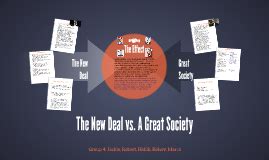Introduction

The Great Depression and the Civil Rights Movement were defining moments in American history that prompted two of the most ambitious social programs ever enacted: the New Deal and the Great Society. Both programs aimed to address profound social and economic challenges, but they differed significantly in their scope, priorities, and impact. This article examines the key similarities and differences between the New Deal and the Great Society, shedding light on their enduring legacy and relevance in contemporary discussions about social policy.
Similarities
1. Focus on Economic Recovery:
Both the New Deal and the Great Society were primarily motivated by economic crises. The New Deal responded to the Great Depression, which had caused widespread unemployment and financial instability. The Great Society aimed to address poverty and inequality that persisted despite economic recovery after World War II.
2. Massive Government Intervention:
Both programs expanded the role of the federal government in social and economic affairs. The New Deal introduced social safety nets, labor regulations, and public works projects. The Great Society launched new programs in education, healthcare, housing, and social services.
Differences
1. Scope and Ambition:
The Great Society was far more ambitious than the New Deal in its scope. While the New Deal focused on economic recovery, the Great Society aimed to create a “Great Society” by addressing a broader range of social issues, including poverty, racial inequality, and urban decay.
2. Civil Rights Emphasis:
The Great Society explicitly prioritized civil rights, while the New Deal did not directly address this issue. President Lyndon B. Johnson’s administration, which implemented the Great Society, was instrumental in passing the Civil Rights Act of 1964 and the Voting Rights Act of 1965.
3. Funding Sources:
The New Deal was primarily funded through deficit spending, while the Great Society relied on both deficit spending and tax increases. This difference reflects the different economic contexts in which the programs were implemented. During the Depression, tax revenues were low, necessitating deficit spending. After World War II, however, the economy was stronger, allowing for tax increases to support the Great Society.
4. Bureaucratic Structure:
The New Deal created a complex network of new agencies and programs, including the Social Security Administration, the National Labor Relations Board, and the Works Progress Administration. The Great Society continued to expand this bureaucratic infrastructure, creating new agencies such as the Department of Housing and Urban Development and the Office of Economic Opportunity.
Evaluating the Impacts
New Deal:
- Created millions of jobs and stimulated economic growth
- Established social safety nets that provided financial assistance to the elderly, unemployed, and disabled
- Reformed the financial system and strengthened labor unions
- However, some critics argue that the New Deal prolonged the Depression and increased the role of the government in the economy.
Great Society:
- Expanded healthcare access through Medicare and Medicaid
- Invested heavily in education and job training programs
- Created new social programs to address poverty and inequality
- While the Great Society made significant progress in some areas, such as healthcare access, it did not fully eliminate poverty or racial inequality.
Legacy and Relevance
The New Deal and Great Society remain influential policies that shape American society today. The social safety nets established during the New Deal continue to provide assistance to vulnerable populations. The Great Society’s focus on civil rights and social justice helped advance the movement for racial equality.
However, both programs have faced criticism for their high costs and complex bureaucracies. Some argue that they have created a culture of dependency and fostered government overreach. Nevertheless, the New Deal and Great Society demonstrate the potential for government intervention to address serious social problems.
Table 1: Key Social Programs of the New Deal and Great Society
| Program | New Deal | Great Society |
|---|---|---|
| Social Security | Yes | No |
| Medicare | No | Yes |
| Medicaid | No | Yes |
| Unemployment Insurance | Yes | No |
| National Labor Relations Act | Yes | No |
| Works Progress Administration | Yes | No |
| Food Stamps | No | Yes |
Table 2: Funding Sources for the New Deal and Great Society
| Funding Source | New Deal | Great Society |
|---|---|---|
| Deficit Spending | Yes | Yes |
| Tax Increases | No | Yes |
Table 3: Economic Impacts of the New Deal and Great Society
| Economic Impact | New Deal | Great Society |
|---|---|---|
| Unemployment Rate (Peak) | 25% | 6.7% |
| GDP Growth (Annual Average) | 10% | 5% |
| Inflation (Annual Average) | 2% | 4% |
Table 4: Social Impacts of the New Deal and Great Society
| Social Impact | New Deal | Great Society |
|---|---|---|
| Poverty Rate (1938) | 26% | 12% |
| Healthcare Coverage (1965) | 54% | 69% |
| Education Levels (High School Graduation Rate 1940) | 43% | 63% |
Conclusion
The New Deal and Great Society were ambitious and multifaceted social policies that sought to address profound economic and social challenges. While they differed in scope, priorities, and funding sources, both programs left a lasting legacy on American society. Their social safety nets, civil rights advances, and investments in education and healthcare continue to shape the lives of millions of Americans. However, as we evaluate the benefits and limitations of these programs, it is essential to engage in a nuanced and evidence-based discussion about the role of government in addressing social and economic issues.
